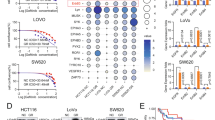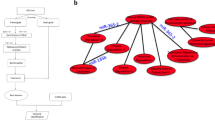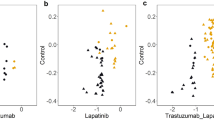Abstract
Axl is a receptor that induces proliferation, migration and invasion in cancer. In this study, we show that specific microRNAs (miRNAs) target the 3′-UTR of Axl. Luciferase-reporter assays with wild-type and deleted miR-34 and miR-199a/b seed sequences of Axl 3′-UTR confirmed the specificity of targeting. An inverse correlation between Axl protein and miR-34a expression in a panel of non-small cell lung cancer (NSCLC), colorectal cancer (CRC) and breast cancer (BRC) cell lines was observed, while miR-199a/b expression was completely suppressed. Pre-miR transfection inhibited in vitro migration and invasion and, in vivo, reduced the number of distant lung- or liver-metastases in a chorion-allantoic-membrane (CAM) assay. Moreover, methylation-specific PCR on bisulfite-converted DNA obtained from the cell lines showed that the miR-34a promoter methylation status was inversely correlated with its expression, and that miR-199a/b promoter regions were methylated in all cells tested. In a panel of NSCLC tissues (n=44), miR-34a and miR-199a/b were found to be downregulated and significantly co-expressed. A lower expression of all three miRs was significantly associated with squamous histotypes, and, in a preliminary series, NSCLC patients with miR-34a upregulation showed a positive association towards a longer survival. These results indicate that Axl receptor expression can be regulated by miR-34a and miR-199a/b, which are suppressed by promoter methylation in solid cancer cells.
This is a preview of subscription content, access via your institution
Access options
Subscribe to this journal
Receive 50 print issues and online access
$259.00 per year
only $5.18 per issue
Buy this article
- Purchase on Springer Link
- Instant access to full article PDF
Prices may be subject to local taxes which are calculated during checkout









Similar content being viewed by others
References
Bommer GT, Gerin I, Feng Y, Kaczorowski AJ, Kuick R, Love RE et al. (2007). p53-mediated activation of miRNA34 candidate tumor-suppressor genes. Curr Biol 17: 1298–1307.
Budagian V, Bulanova E, Orinska Z, Duitman E, Brandt K, Ludwig A et al. (2005). Soluble Axl is generated by ADAM10-dependent cleavage and associates with Gas6 in mouse serum. Mol Cell Biol 25: 9324–9339.
Burchert A, Attar EC, McCloskey P, Fridell YW, Liu ET . (1998). Determinants for transformation induced by the Axl receptor tyrosine kinase. Oncogene 16: 3177–3187.
Chang TC, Wentzel EA, Kent OA, Ramachandran K, Mullendore M, Lee KH et al. (2007). Transactivation of miR-34a by p53 broadly influences gene expression and promotes apoptosis. Mol Cell 26: 745–752.
Chen R, Alvero AB, Silasi DA, Kelly MG, Fest S, Visintin I et al. (2008). Regulation of IKKbeta by miR-199a affects NF-kappaB activity in ovarian cancer cells. Oncogene 27: 4712–4723.
Cheung HH, Lee TL, Davis AJ, Taft DH, Rennert OM, Chan WY . (2010). Genome-wide DNA methylation profiling reveals novel epigenetically regulated genes and non-coding RNAs in human testicular cancer. Br J Cancer 102: 419–427.
Cho WC . (2007). OncomiRs: the discovery and progress of microRNAs in cancers. Mol Cancer 6: 60.
Doench JG, Sharp PA . (2004). Specificity of microRNA target selection in translational repression. Genes Dev 18: 504–511.
Dumont N, Wilson MB, Crawford YG, Reynolds PA, Sigaroudinia M, Tlsty TD . (2008). Sustained induction of epithelial to mesenchymal transition activates DNA methylation of genes silenced in basal-like breast cancers. Proc Natl Acad Sci USA 105: 14867–14872.
Erson AE, Petty EM . (2008). MicroRNAs in development and disease. Clin Genet 74: 296–306.
Esteller M . (2007). Cancer epigenomics: DNA methylomes and histone-modification maps. Nat Rev Genet 8: 286–298.
Eulalio A, Huntzinger E, Izaurralde E . (2008). Getting to the root of miRNA-mediated gene silencing. Cell 132: 9–14.
Feinberg AP, Tycko B . (2004). The history of cancer epigenetics. Nat Rev Cancer 4: 143–153.
Fridell YW, Villa Jr J, Attar EC, Liu ET . (1998). GAS6 induces Axl-mediated chemotaxis of vascular smooth muscle cells. J Biol Chem 273: 7123–7126.
Gallardo E, Navarro A, Vinolas N, Marrades RM, Diaz T, Gel B et al. (2009). miR-34a as a prognostic marker of relapse in surgically resected non-small-cell lung cancer. Carcinogenesis 30: 1903–1909.
Garzia L, Andolfo I, Cusanelli E, Marino N, Petrosino G, De Martino D et al. (2009). MicroRNA-199b-5p impairs cancer stem cells through negative regulation of HES1 in medulloblastoma. PLoS One 4: e4998.
Goruppi S, Ruaro E, Varnum B, Schneider C . (1997). Requirement of phosphatidylinositol 3-kinase-dependent pathway and Src for Gas6-Axl mitogenic and survival activities in NIH 3T3 fibroblasts. Mol Cell Biol 17: 4442–4453.
Gupta GP, Massague J . (2006). Cancer metastasis: building a framework. Cell 127: 679–695.
Hafizi S, Dahlback B . (2006). Gas6 and protein S. Vitamin K-dependent ligands for the Axl receptor tyrosine kinase subfamily. FEBS J 273: 5231–5244.
He L, He X, Lim LP, de Stanchina E, Xuan Z, Liang Y et al. (2007). A microRNA component of the p53 tumour suppressor network. Nature 447: 1130–1134.
Lee WP, Wen Y, Varnum B, Hung MC . (2002). Akt is required for Axl-Gas6 signaling to protect cells from E1A-mediated apoptosis. Oncogene 21: 329–336.
Li Y, Guessous F, Zhang Y, Dipierro C, Kefas B, Johnson E et al. (2009). MicroRNA-34a inhibits glioblastoma growth by targeting multiple oncogenes. Cancer Res 69: 7569–7576.
Lodygin D, Tarasov V, Epanchintsev A, Berking C, Knyazeva T, Korner H et al. (2008). Inactivation of miR-34a by aberrant CpG methylation in multiple types of cancer. Cell Cycle 7: 2591–2600.
Lujambio A, Calin GA, Villanueva A, Ropero S, Sanchez-Cespedes M, Blanco D et al. (2008). A microRNA DNA methylation signature for human cancer metastasis. Proc Natl Acad Sci USA 105: 13556–13561.
Lujambio A, Esteller M . (2009). How epigenetics can explain human metastasis: a new role for microRNAs. Cell Cycle 8: 377–382.
McCloskey P, Fridell YW, Attar E, Villa J, Jin Y, Varnum B et al. (1997). GAS6 mediates adhesion of cells expressing the receptor tyrosine kinase Axl. J Biol Chem 272: 23285–23291.
Melaragno MG, Cavet ME, Yan C, Tai LK, Jin ZG, Haendeler J et al. (2004). Gas6 inhibits apoptosis in vascular smooth muscle: role of Axl kinase and Akt. J Mol Cell Cardiol 37: 881–887.
Mudduluru G, Allgayer H . (2008). The human receptor tyrosine kinase Axl gene—promoter characterization and regulation of constitutive expression by Sp1, Sp3 and CpG methylation. Biosci Rep 28: 161–176.
Mudduluru G, Vajkoczy P, Allgayer H . (2010). Myeloid zinc finger 1 induces migration, invasion, and in vivo metastasis through Axl gene expression in solid cancer. Mol Cancer Res 8: 159–169.
O'Bryan JP, Fridell YW, Koski R, Varnum B, Liu ET . (1995). The transforming receptor tyrosine kinase, Axl, is post-translationally regulated by proteolytic cleavage. J Biol Chem 270: 551–557.
Raver-Shapira N, Marciano E, Meiri E, Spector Y, Rosenfeld N, Moskovits N et al. (2007). Transcriptional activation of miR-34a contributes to p53-mediated apoptosis. Mol Cell 26: 731–743.
Sainaghi PP, Castello L, Bergamasco L, Galletti M, Bellosta P, Avanzi GC . (2005). Gas6 induces proliferation in prostate carcinoma cell lines expressing the Axl receptor. J Cell Physiol 204: 36–44.
Stenhoff J, Dahlback B, Hafizi S . (2004). Vitamin K-dependent Gas6 activates ERK kinase and stimulates growth of cardiac fibroblasts. Biochem Biophys Res Commun 319: 871–878.
Tazawa H, Tsuchiya N, Izumiya M, Nakagama H . (2007). Tumor-suppressive miR-34a induces senescence-like growth arrest through modulation of the E2F pathway in human colon cancer cells. Proc Natl Acad Sci USA 104: 15472–15477.
Tili E, Michaille JJ, Gandhi V, Plunkett W, Sampath D, Calin GA . (2007). miRNAs and their potential for use against cancer and other diseases. Future Oncol 3: 521–537.
Toyota M, Suzuki H, Sasaki Y, Maruyama R, Imai K, Shinomura Y et al. (2008). Epigenetic silencing of microRNA-34b/c and B-cell translocation gene 4 is associated with CpG island methylation in colorectal cancer. Cancer Res 68: 4123–4132.
Vajkoczy P, Knyazev P, Kunkel A, Capelle HH, Behrndt S, von Tengg-Kobligk H et al. (2006). Dominant-negative inhibition of the Axl receptor tyrosine kinase suppresses brain tumor cell growth and invasion and prolongs survival. Proc Natl Acad Sci USA 103: 5799–5804.
Valeri N, Vannini I, Fanini F, Calore F, Adair B, Fabbri M . (2009). Epigenetics, miRNAs, and human cancer: a new chapter in human gene regulation. Mamm Genome 20: 573–580.
van Ginkel PR, Gee RL, Shearer RL, Subramanian L, Walker TM, Albert DM et al. (2004). Expression of the receptor tyrosine kinase Axl promotes ocular melanoma cell survival. Cancer Res 64: 128–134.
Weber M, Hellmann I, Stadler MB, Ramos L, Paabo S, Rebhan M et al. (2007). Distribution, silencing potential and evolutionary impact of promoter DNA methylation in the human genome. Nat Genet 39: 457–466.
Weinberg RA . (1995). The molecular basis of oncogenes and tumor suppressor genes. Ann N Y Acad Sci 758: 331–338.
Welch C, Chen Y, Stallings RL . (2007). MicroRNA-34a functions as a potential tumor suppressor by inducing apoptosis in neuroblastoma cells. Oncogene 26: 5017–5022.
Wu CW, Li AF, Chi CW, Lai CH, Huang CL, Lo SS et al. (2002). Clinical significance of AXL kinase family in gastric cancer. Anticancer Res 22: 1071–1078.
Yeligar S, Tsukamoto H, Kalra VK . (2009). Ethanol-induced expression of ET-1 and ET-BR in liver sinusoidal endothelial cells and human endothelial cells involves hypoxia-inducible factor-1alpha and microrNA-199. J Immunol 183: 5232–5243.
Zhao Y, Srivastava D . (2007). A developmental view of microRNA function. Trends Biochem Sci 32: 189–197.
Acknowledgements
HA was supported by Alfried Krupp von Bohlen und Halbach Foundation, Essen, Hella-Bühler-Foundation, Heidelberg, Dr Ingrid zu Solms Foundation, Frankfurt/Main, Hector Foundation, Weinheim, Germany, FRONTIER Excellence Initiative of the University of Heidelberg, the BMBF, Bonn, Germany, and Walter Schulz Foundation, Munich, Germany. We thank Erika Hillerich and Laura Nelson for excellent help and critical appraisal of the manuscript.
Author information
Authors and Affiliations
Corresponding author
Ethics declarations
Competing interests
The authors declare no conflict of interest.
Additional information
Supplementary Information accompanies the paper on the Oncogene website
Supplementary information
Rights and permissions
About this article
Cite this article
Mudduluru, G., Ceppi, P., Kumarswamy, R. et al. Regulation of Axl receptor tyrosine kinase expression by miR-34a and miR-199a/b in solid cancer. Oncogene 30, 2888–2899 (2011). https://doi.org/10.1038/onc.2011.13
Received:
Revised:
Accepted:
Published:
Issue Date:
DOI: https://doi.org/10.1038/onc.2011.13
Keywords
This article is cited by
-
A first-in-class fully modified version of miR-34a with outstanding stability, activity, and anti-tumor efficacy
Oncogene (2023)
-
Axl regulated survival/proliferation network and its therapeutic intervention in mouse models of glomerulonephritis
Arthritis Research & Therapy (2022)
-
A microRNA binding site polymorphism in the 3′ UTR region of VEGF-A gene modifies colorectal cancer risk based on ethnicity: a meta-analysis
Journal of the Egyptian National Cancer Institute (2022)
-
The comprehensive landscape of miR-34a in cancer research
Cancer and Metastasis Reviews (2021)
-
TAM family receptors in conjunction with MAPK signalling are involved in acquired resistance to PI3Kα inhibition in head and neck squamous cell carcinoma
Journal of Experimental & Clinical Cancer Research (2020)



